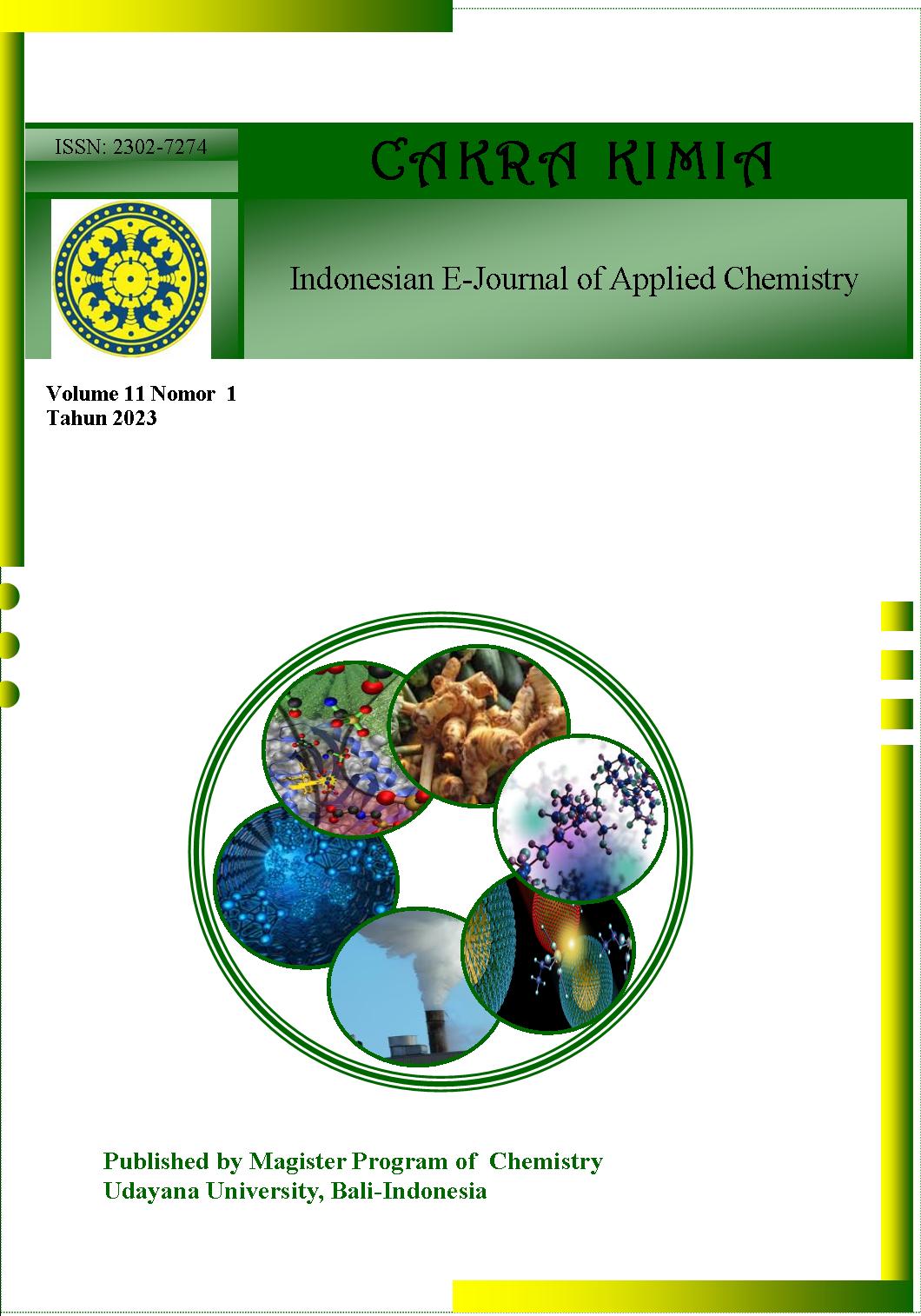DESAIN PRIMER SECARA IN SILICO UNTUK AMPLIFIKASI GEN COA PADA STAPHYLOCOCCUS AUREUS DENGAN POLYMERASE CHAIN REACTION
Abstract
ABSTRAK: Staphylococcus aureus merupakan bakteri penyebab berbagai infeksi kulit dan jaringan lunak serta penyebab penyakit yang lebih serius dan lebih invasif. Gen coa adalah gen penyandi enzim koagulase yang dimiliki Staphylococcus aureus. Gen coa dapat dideteksi dengan teknik Polymerase Chain Reaction (PCR). Metode PCR memerlukan sepasang primer. Primer dapat didesain secara in silico. Penelitian ini bertujuan untuk mengetahui apakah primer yang digunakan dapat memgamplifikasi gen coa pada Staphylococcus aureus. Primer didesain menggunakan software NCBI kemudian dilakukan uji kualitas primer menggunakan software oligoevaluator dan NetPrimers. Didapatkan 2 kandidat primer yaitu primer pertama forward 5’ CAAAGCAGATGCGATAGTGG 3’ reverse 5’ GTTCGCTTTATTTTCCGGCT 3’ dan primer kedua dengan forward 5’ AGCCGGAAAATAAAGCGAAC 3’ reverse 5’ ACCTTGAATTGTGCCTTGTG 3’. Hasil primer yang didesain diujikan dengan metode PCR. Hasil visualisasi kedua primer terbentuk pita DNA yang tebal dan jelas, tidak ada smear, namun terdapat primer dimer dan letak produk tidak sesuai dengan hasil analisis secara in silico. Primer yang didesain dapat digunakan untuk amplifikasi gen coa pada Staphylococcus aureus. Terdapat perbedaan spesifisitas antar primer yang didesain dimana primer 2 lebih baik dari primer 1.
ABSTRACT: Staphylococcus aureus is bacteria that causes of a variety of skin and soft tissue infections and causes more serious and invasive disease. The coa gene is a coagulase enzyme gene that belongs to Staphylococcus aureus. The coa gene can be detected by Polymerase Chain Reaction (PCR) technique. The PCR method requires primers. Primer can be designed in silico. This study aims to determine whether the primer used can amplify the coa gene in Staphylococcus aureus. Primers were designed using NCBI software and then tested for primary quality using oligoevaluator and NetPrimers software. Two primary candidates were obtained, namely the first primer forward 5' CAAAGCAGATGCGATAGTGG 3' reverse 5' GTTCGCTTTATTTTCCGGCT 3' and the second primer forward 5' AGCCGGAAAATAAAGCGAAC 3' reverse 5' ACCTTGAATTGTGCCTTGTGTG 3'. The designed primary results were tested by the PCR method. The results of the visualization of the two primers formed thick and clear DNA bands, no smears, but there were dimer primers and the location of the products did not match the results of in silico analysis. The designed primer can be used for coa gene amplification in Staphylococcus aureus. There are differences in specifications between the designed primers where primer 2 is better than primary 1.
Downloads
References
[2] Wahyuni, R. A., Darmawati, S., & Prastiyanto, M. E. (2017). Deteksi Gen coa Pada Staphylococcus aureus Yang Diisolasi Dari Susu Sapi Murni. Jurnal Prosiding Nasional Publikasi Hasil-Hasil Penelitian Dan Pengabdian Masyarakat.
[3] Kobayashi, S. D., Malachowa, N., & Deleo, F. R. (2015). Pathogenesis of Staphylococcus aureus abscesses. In American Journal of Pathology, 185 (6), 1518–1527
https://doi.org/10.1016/j.ajpath.2014.11.030
[4] Syamsidi, A., Aanisah, N., Fiqram, R., & Jultri, I. al. (2021). Primer Design and Analysis for Detection of mecA gene. Journal of Tropical Pharmacy and Chemistry, 5(3), 245–253. https://doi.org/10.25026/jtpc.v5i3.297
[5] Sasmitha, L. V., Yustiantara, P. S., & Yowani, S. C. (2018). Desain DNA Primer Secara In Silico Sebagai Pendeteksi Mutasi Gen gyrA Mycrobacterium tuberculosis Untuk Metode Polymerase Chain Reaction. Cakra Kimia (Indonesian E-Journal of Applied Chemistry), 6(1), 63–69.
[6] Hikmatyar, M., Ida Royani, J. (2015). Bioteknologi & Biosains Indonesia Isolasi Dan Amplifikasi DNA Keladi Tikus (Thyponium flagelliform) Untuk Identifikasi Keragaman Genetik Isolation and amplification of Keladi tikus (Thyponium flagelliform) DNA for identification of genetic variation. Jurnal Bioteknologi & Biosains Indonesia, 2, 42–48.
[7] Farmawati, D. A., Nengah Wirajana, I., & Yowani, S. C. (2015). Perbandingan Kualitas DNA Dengan Menggunakan Metode Boom Original Dan Boom Modifikasi Pada Isolat Mycobacterium tuberculosis 151. Jurnal Kimia, 9, 41–46.
[8] Anika, M., & Hilda Putri, D. (2019). Primer Design For Identification Of Beta-Carotene Encoding Genes In Cassava. Jurnal Bio Sains, 4(1): 39–47.
[9] Sasmito, D. E. K., Rahadian, K., & Muhimmah, I. (2014). Karakteristik Primer pada Polymerase Chain Reaction (PCR) untuk Sekuensing DNA: Mini Review. Seminar Nasional Informatika Medis, 5: 94–102.
[10] Praja & Rosalina. (2021). Perancangan Primer Gen IktB pada Fusobacterium necrophorum untuk Analisis PCR. Jurnal Sains dan Teknologi Pertanian, 2(2), 47-55.
[11] Yuenleni. (2019). Langkah-Langkah Optimasi PCR. Indonesian Journal Of Laboratory, 1(3), 51-56.
[12] Aris, M., Sukenda., Harris E., Sukadi, F.M., & Yuhana. (2013). Identifikasi Molekuler Bakteri Patogen dan Desain Primer PCR. Jurnal Budidaya Perairan, 1(3), 43-50.
[13] Sihotang, D. E. A. M., Erwinda, E.Y., Suwarni, E., Lusianti, E. (2021). Desain Primer dan Analisis in Silico untuk Amplifikasi Gen mt-Co1 pada Tikus got (Rattus norvegicus). Jurnal Eruditio, 1(2), 20-29.
[14] Yustinadewi, D. P., Yustiantara, P. S., & Narayani, I. (2018). MDR-1 Gene 1199 Variant Primer Design Techniques In Pediatric Patient Buffy Coat Samples With LLA. Jurnal Metamorfosa of Biological Siences, 5(1), 105–111.



 Petunjuk Penulisan
Petunjuk Penulisan
